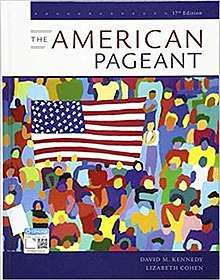The American Pageant
The American Pageant, initially published by Thomas A. Bailey in 1956,[1] is an American high school history textbook often used for AP United States History, AICE American History as well as IB History of the Americas courses. Since Bailey's death in 1983, the book has been updated by historians David M. Kennedy and Lizabeth Cohen, and it is now in its seventeenth edition.
 The American Pageant, Seventeenth Edition | |
| Author | Thomas A. Bailey David Kennedy Lizabeth Cohen |
|---|---|
| Illustrator | Nathan Roe |
| Country | United States |
| Language | English |
| Subject | United States history |
| Publisher | Cengage Learning |
Publication date | 1 January 2019 |
| Pages | 1152 |
| ISBN | 978-1337616225 |
| Preceded by | The American Pageant- Sixteenth Edition |
Structure
Twelfth edition
Four different versions of the 12th edition were printed. All are divided into six parts, from "Founding the New Nation" (with an initial chapter on prehistory, natives, and European exploration) through "Making Modern America." The six parts are subdivided into a total of 42 chapters spanning 1034 pages. The book's chronology officially ends in the year 2001, though later printings include an additional three paragraphs detailing the 2004 US election as well as September 11. Since then, the incumbent edition of the American Pageant included information regarding the 2008 presidential election.
The four versions of the Twelfth Edition are the Complete Edition, the version "For Advanced High School Courses," published by Houghton Mifflin. There are also two editions that split the textbook into two volumes: Volume I, which covers American history up to 1877, and Volume II, which covers the American history since 1865.
Thirteenth edition
The thirteenth edition, released in 2006, contains 42 chapters in six parts. The book's chronology is updated, briefly covering the United States' invasion of Afghanistan, the 2003 invasion of Iraq, and the USA PATRIOT Act. Chapters 27 and 28 from the 12th Edition were combined in the 13th edition.
Fourteenth edition
The fourteenth edition, released in 2010, contains 42 chapters in six parts. This edition adds twelve new "Thinking Globally" essays and many new box-quotes adding more international voices to the events chronicled in the book's historical narrative. The "Varying Viewpoints" essays were updated reflecting new interpretations of significant trends and events, as well as concern for their global context. The text's global focus is renewed and strengthened. Also the edition has new and revised primary source features called "Examining the Evidence".
Fifteenth edition
The fifteenth edition, released in 2013, contains 42 chapters in six parts. This edition includes markedly deeper cultural innovations, artistic movements, and intellectual doctrines that have engaged and inspired Americans and shaped the course of history of the United States, new "Thinking Globally" essay on twentieth-century modernism in Chapter 31, new "Makers of America" feature on Beat Generation of the 1950s in Chapter 37. The book's tables, graphs, Key Terms, People to Know, and To Learn More sections are also updated. This is the first edition in which Bailey is not credited as an author on the cover and the title page.[1] The textbook covers American history up until the September 11 attacks.
Sixteenth edition
The sixteenth edition, released in 2015, contains 41 chapters in six parts. This edition's Part Six, which covers post-1945 period is revised. Chapters 29 and 30 from the 15th Edition were combined in the sixteenth edition. Each chapter has a new feature called “Contending Voices”, which offers paired quotes from original historical sources, accompanied by questions which prompt students to think about conflicting perspectives on controversial subjects. It also extends the textbook's historical coverage to the year 2014.
Evaluation
Historian Emil Pocock, evaluating the 10th edition of 1994, argues that the publisher has made a special effort to be more approachable for beginning students by using a more basic vocabulary, simpler concepts, and features designed to aid learning. This textbook, he says, therefore uses easy syntax, unsophisticated interpretations, and gives only limited coverage to complex and controversial topics. The typeface is large, and the page layout is generous with many color illustrations. It gives a basic political narrative emphasizing great men and famous events, although it does include new topics regarding diversity of race and gender. Pocock states:
It is at heart a patriotic work that celebrates American progress and the free enterprise system, while largely ignoring dissenting political viewpoints outside the mainstream. Sidebars present broader historiographic interpretations, but the context seems clearly intended to convey the notion that these other views are mistaken in some way.[2]
References
- Raphael, Ray (April 26, 2015). "Thomas A. Bailey: Dead and Forgotten by His Publisher?". History News Network. Retrieved April 29, 2015.
- Peter J. Parish, ed. Reader's Guide to American History (1997) p 693
- Bailey, Thomas. The American Pageant, A History of the Republic. Vol.1, 4th Edition. Lexington, Massachusetts: D.C. Heath and Company, 1971.
External links
- Textbook Site for "The American Pageant: A History of the Republic, 11th Edition"
- Textbook Site for "The American Pageant: A History of the Republic, 12th Edition"
- Instructor Website for "The American Pageant: A History of the Republic, 13th Edition"
- Student Website for "The American Pageant: A History of the Republic, 13th Edition"
- Instructor Website for "The American Pageant, 14th Edition"
- Student Website for "The American Pageant, 14th Edition"
- Instructor Website for "The American Pageant, 15th Edition"
- Student Website for "The American Pageant, 15th Edition"
- Instructor Website for "The American Pageant, 16th Edition"